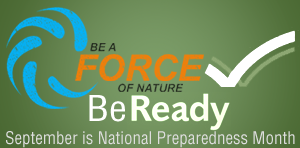 September is National Preparedness Month. It is a time to prepare yourself and those in your care for emergencies and disasters. You know that emergencies can happen unexpectedly in communities just like yours, to people like you. We’ve seen tornado outbreaks, river floods and flash floods, historic earthquakes, tsunamis, and even water main breaks and power outages in U.S. cities affecting millions of people for days at a time. Police, fire and rescue may not always be able to reach you quickly in an emergency or disaster. The most important step you can take in helping your local responders is being able to take care of yourself and those in your care; the more people who are prepared, the quicker the community will recover This September, please prepare and plan in the event you must go for three days without electricity, water service, access to a supermarket, or local services for several days. National Preparedness Month culminates on September 30th with National Preparedness Day, the national day of action.
September is National Preparedness Month. It is a time to prepare yourself and those in your care for emergencies and disasters. You know that emergencies can happen unexpectedly in communities just like yours, to people like you. We’ve seen tornado outbreaks, river floods and flash floods, historic earthquakes, tsunamis, and even water main breaks and power outages in U.S. cities affecting millions of people for days at a time. Police, fire and rescue may not always be able to reach you quickly in an emergency or disaster. The most important step you can take in helping your local responders is being able to take care of yourself and those in your care; the more people who are prepared, the quicker the community will recover This September, please prepare and plan in the event you must go for three days without electricity, water service, access to a supermarket, or local services for several days. National Preparedness Month culminates on September 30th with National Preparedness Day, the national day of action.
The National Weather Service is proud to be participating in NPM. By doing so, we want to make sure YOU are prepared in case of a disaster (natural or man-made). If you haven't taken the time to think about how different disasters could effect you, then we challenge you to take the necessary steps to become informed and develop a family plan for such events. These simple steps could SAVE YOUR LIFE!
Step 1: Learn Your Risks & Responses - Be Informed!
- Emergency Alerts: You can receive important lifesaving alerts no matter where you are - home, school, or work.
- Social Medial: Some weather & safety information can also be relayed through social media. However, please remember that this is NOT an official means of receiving important lifesaving information.
- Natural Disasters: Know which natural disasters can occur in your area and how each could affect you.
- Other Hazards: Remember to plan for things such as pandemics, terrorist attacks, etc.
Step 2: Make a Plan!
It is important to make a family emergency plan that can be put into action as soon as disaster strikes. Make sure to include plans for children, seniors, disabled, and don't forget pets!
Step 3: Build a Supply Kit!
 |
A supply kit is a must when planning for potential disasters. You need to make sure you and your family have the necessary food and supplies to sustain you until the power returns or help arrives. It is also important to keep the kit maintained by keeping food/water fresh and supplies working properly. It is typically best to store the kit, along with any pet supplies, in a closet or the basement. |
| Step 4: Get Involved! |
|
Find opportunities to support community preparedness. There are many ways to get involved before disaster strikes. So, ask yourself, "How can I help?"
|
| Other Resources & Contacts: |
 |
